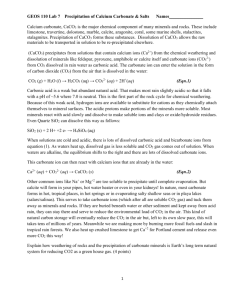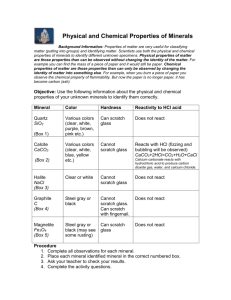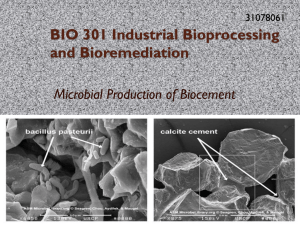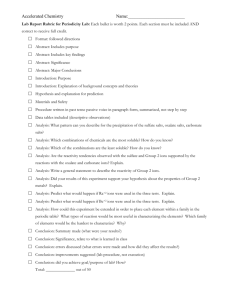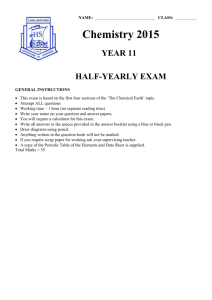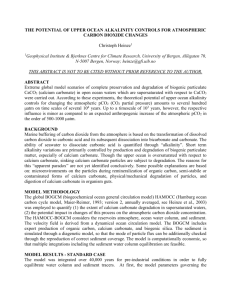GEOS 110 Lab 7 Precipitation of Calcium Carbonate & Salts
advertisement
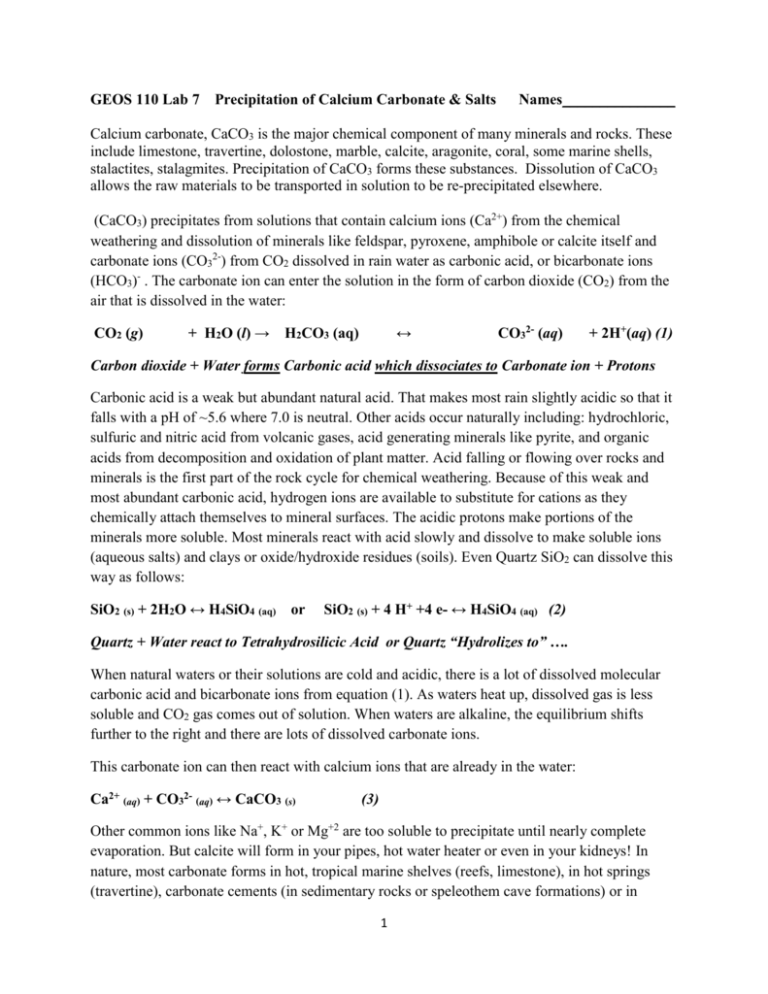
GEOS 110 Lab 7 Precipitation of Calcium Carbonate & Salts Names_______________ Calcium carbonate, CaCO3 is the major chemical component of many minerals and rocks. These include limestone, travertine, dolostone, marble, calcite, aragonite, coral, some marine shells, stalactites, stalagmites. Precipitation of CaCO3 forms these substances. Dissolution of CaCO3 allows the raw materials to be transported in solution to be re-precipitated elsewhere. (CaCO3) precipitates from solutions that contain calcium ions (Ca2+) from the chemical weathering and dissolution of minerals like feldspar, pyroxene, amphibole or calcite itself and carbonate ions (CO32-) from CO2 dissolved in rain water as carbonic acid, or bicarbonate ions (HCO3)- . The carbonate ion can enter the solution in the form of carbon dioxide (CO2) from the air that is dissolved in the water: CO2 (g) + H2O (l) → H2CO3 (aq) ↔ CO32- (aq) + 2H+(aq) (1) Carbon dioxide + Water forms Carbonic acid which dissociates to Carbonate ion + Protons Carbonic acid is a weak but abundant natural acid. That makes most rain slightly acidic so that it falls with a pH of ~5.6 where 7.0 is neutral. Other acids occur naturally including: hydrochloric, sulfuric and nitric acid from volcanic gases, acid generating minerals like pyrite, and organic acids from decomposition and oxidation of plant matter. Acid falling or flowing over rocks and minerals is the first part of the rock cycle for chemical weathering. Because of this weak and most abundant carbonic acid, hydrogen ions are available to substitute for cations as they chemically attach themselves to mineral surfaces. The acidic protons make portions of the minerals more soluble. Most minerals react with acid slowly and dissolve to make soluble ions (aqueous salts) and clays or oxide/hydroxide residues (soils). Even Quartz SiO2 can dissolve this way as follows: SiO2 (s) + 2H2O ↔ H4SiO4 (aq) or SiO2 (s) + 4 H+ +4 e- ↔ H4SiO4 (aq) (2) Quartz + Water react to Tetrahydrosilicic Acid or Quartz “Hydrolizes to” …. When natural waters or their solutions are cold and acidic, there is a lot of dissolved molecular carbonic acid and bicarbonate ions from equation (1). As waters heat up, dissolved gas is less soluble and CO2 gas comes out of solution. When waters are alkaline, the equilibrium shifts further to the right and there are lots of dissolved carbonate ions. This carbonate ion can then react with calcium ions that are already in the water: Ca2+ (aq) + CO32- (aq) ↔ CaCO3 (s) (3) Other common ions like Na+, K+ or Mg+2 are too soluble to precipitate until nearly complete evaporation. But calcite will form in your pipes, hot water heater or even in your kidneys! In nature, most carbonate forms in hot, tropical marine shelves (reefs, limestone), in hot springs (travertine), carbonate cements (in sedimentary rocks or speleothem cave formations) or in 1 evaporating salty shallow seas or in playa lakes (salt deposits from salars/salinas). This serves to take carbonate ions (which after all are soluble CO2 gas) and tuck them away as minerals and rocks. If they are buried beneath warm salty water or other sediments beneath the tropic seas and kept away from acid rain, (or cold acidic sea water in the deepest ocean) they can stay there and serve to reduce the environmental load of CO2 in the air. This kind of natural carbon storage like the growth of the Great Barrier Reef off Australia, will eventually reduce the CO2 in the air but, left to its own slow pace, this will takes tens of millions of years just by weathering of rocks and precipitation of limestones alone. Meanwhile we are making more by burning more fossil fuels and slash in tropical rain forests. We also heat up crushed limestone to get lime (CaO), Ca+2 for Portland cement and release even more CO2 this way! This latter industrial activity from burning fossil fuels and decrepitating limestone generates 5% of the CO2 produced globally. A. Experiment Equipment: calcium chloride (CaCl2 solution), sodium carbonate (Na2CO3) solution; graduated cylinders, beakers, ring stand, filter paper, aluminum foil, binocular microscopes, natural calcium carbonate; weak hydrochloric acid in bottles; sea water; streak plates, evaporate minerals; Bunsen burners Procedure: Measure out 10 mL of aqueous calcium chloride, CaCl2 solution in a graduated cylinder. This provides the Ca2+ ions as in equation (3) above. In a separate graduated cylinder, measure out 10 mL of sodium carbonate, Na2CO3 solution. This provides the CO32- ions as in eqn (3) above. 1. Observe the nature of the separate solutions and describe them here. ____________________ ______________________________________________________________________________ ___________________________________________________________________________ (2) 2. Write the total ionic equation for the 2 solutions you brought together and any products you produced. Note: Both the Cl- and Na+ are highly soluble and will be present both before and after the reactions. They are “spectator ions”, just there for the charge balance and along for the ride! Write your equation here: ___________________________________________________________________________ (5) 3. Pour both solutions into the same small beaker. Record your observations. ________________ _____________________________________________________________________________ __________________________________________________________________________ (2) 2 The solid is a precipitate of calcium carbonate, CaCO3. This compound has low solubility in water and readily precipitates out of the solution. Although the reaction is not exactly the same as most precipitations in nature, it demonstrates the nature of solid forming from liquid, without any freezing. CaCl2 (aq) + Na2CO3 (aq) CaCO3 (s) + 2NaCl (aq) (4) Similar reaction can occur between briny formation water and fresher runoff, hot geyser fluids and fresher groundwater or between runoff and playa lakes. 4. It is possible to separate the calcium carbonate from the sodium chloride remaining in solution in the water by filtration. Write your name on the edge of a piece of filter paper with water fast ink. Weigh it and record the weight of your paper to 2 decimal places. Filter paper ______ g (1) Procedure: Fold a filter paper in half, then in half again. Open it up as a conical shape and fit it into a funnel. Support the funnel in a small ring (second drawer in bench) attached to a lab stand (middle cupboard in bench). a. Pour the mixture through the filter, and collect the liquid in a beaker. We will use this next so save it! The residue in the filter paper is the calcium carbonate. Remove the filter paper and open it out and lay it face up with your crystal residue on a paper towel to wick away any excess salt water. Spread the filter paper on a piece of aluminum foil and to allow the CaCO3 to dry on a hot plate for a few minutes at low heat. Weight your paper dry with CaCO3 ______________g (1) b. While your filter paper and precipitate are drying out, evaporate your little beaker or evaporating dish of <20 mL of solution. According towhat remains after reaction 4 above, this should be just salt water. Once it dries out and cools off, examine and describe the crystal residue under a hand lens or binocular microscope and draw and describe the crystal shapes you see. There are samples of all the common evaporate minerals in the lab for you to compare to. (2) Draw them here: 5. Obtain a separate sample of natural calcium carbonate, powder it on a streak plate and test its reaction to a few drops of weak hydrochloric acid. Chemically, this will add protons back onto the carbonate ion, making some carbonic acid, which in turn will then dissociate back to CO2 and water as follows: CaCO3 (s) + 2 HCl (aq) → H2CO3 (aq) + CaCl2 (aq) (5) The carbonic acid then does equation (1) backwards: H2CO3 (aq) → CO2 (g) + H2O (l) (1R) 3 a. Compare a pinch of your precipitate to natural calcite powder, side by side on a dark streak plate, and describe the results. This should convince you that you have precipitated Calcite which is the first mineral salt to form on evaporation of any hard briny warm natural waters. Compare the reaction of the natural calcite powder to your precipitate: ____________________ _____________________________________________________________________________ ___________________________________________________________________________ (2) 6. Compared to the inorganic precipitation of Calcite we performed, look at representative natural limestones and note some of their more complex structures, textures and the nature of their grains. Examine and describe each rock briefly in the table below. (20) Rock Name Grain Composition Structures Textures Biology Fossils Other Characteristics 1. Coquina 2. Fossiliferous Limestone 3. Dolostone 4. Chalk 5. Travertine 7. Which of the rocks above represent simple inorganic precipitation of calcite as in our mixed or evaporated solutions and comment on how common these types are? ______________________ ______________________________________________________________________________ ______________________________________________________________________________ ______________________________________________________________________________ ______________________________________________________________________________ ______________________________________________________________________________ ___________________________________________________________________________ (2) 4 8. Reflect on the other rocks from this set and comment on other biogeochemical cycles and discuss their significance to a.) the rock cycle, b.) the carbon cycle). What sort of systems and system interactions (hydrosphere, atmosphere, biosphere, geosphere) do these rocks represent and how long it might take to form them (or destroy them)? ____________________________ ____________________________________________________________________________ ____________________________________________________________________________ ____________________________________________________________________________ ____________________________________________________________________________ ____________________________________________________________________________ ____________________________________________________________________________ ____________________________________________________________________________ __________________________________________________________________________ (10) 9. The Seas are all salty with about 35 per mil salinity. In the 1880’s, Usiglio did an experiment taking a bucket of Mediterranean sea water and he evaporated it to dryness. Solubility and precipitation are empirical phenomena (WYSIWYG). This is because water as a strong dipole arranges itself around the ions for various salts in particular geometries that change with: salinity, temperature and the composition of other ions in solution. Precipitation is basically a dehydration reaction, which requires the removal of solvation water from around and between ions before they can collide and precipitate as a solid. Strangely enough, NaCl is not the first mineral to form. The order Usiglio found was: Usiglio’s experiment 1. CaCO3 Calcite 2. CaSO4 or CaSO4 – 2H2O Anhydrite or Gypsum 3. NaCl Halite 4. MgSO4 Epsomite (Kieserite) 5. MgCl Bischofite 6. Complex K-Mg-Cl-SO4-OH & KCl Bitterns: Carnallite, Langbeinite, Polyhalite, Kainite, respectively: (KMgCl3 * 6H2O , K2Mg2(SO4)3 , K2Ca2Mg(SO4)6 * H2O , KMg(SO4)Cl * 3H2O) 7. KCl Sylvite In addition to these minerals, Usiglio found small amounts of iron oxy-hydroxides and NaBr which more usually forms impurities as does NaI, in Halite. Waters on land are far more varied in their chemistry due to the composition of the local bedrock and minerals undergoing weathering. Complex carbonate chlorides, sulphate chlorides and borates are often present as 5 well as salts of rarer elements like Lithium, Strontium, Barium etc. These constitute only traces in marine waters whose chemistry is dominated by the submarine weathering of basalt. a. It is geologically common to find the 1st 3 minerals from Usiglio’s list in evaporate deposits but exceedingly rare to find anything in the lower part of the list. For this reason those salts are the most valuable. Examine the evaporate minerals from our collection. Some of them are quite delicate, so try not to break or dissolve them. Find minerals from the list above and describe how they are different. (28) Salt formula Mineral Name Colour Crystal Form Composition Other Description 1. CaCO3 2. Anhydrite Gypsum 3. NaCl 4. MgSO4 5. MgCl 6. Bitterns: 7. KCl b. Repeat Usiglio’s experiment. Obtain a 20 mL sample of natural sea water. Evaporate it until crystals start to form when about ~98% of the liquid has boiled off. Describe your first crystal residue and test it with a drop of acid. _______________________________________________ __________________________________________________________________________ (2) 6 c. Continue evaporating your beaker of sea water to dryness. Describe the final crystals that form and try and identify what they are. ________________________________________________ ___________________________________________________________________________ ___________________________________________________________________________(2) 10. In geological history major periods of evaporation have removed salts from the ocean and left sedimentary salt deposits now to be found on land. The following is a list of ages of evaporation and major basins where they occur. Age of Evaporites Location 1. Quaternary Utah, Nevada, Chile (Atacama), Western Australia (Shark Bay) 2. Miocene Mediterranean, Poland 3. Mesozoic (Cretaceous) US Gulf Coast, Yucatan, 4. Triassic (& Jurassic) Atlantic all continents, Nova Scotia, New Brunswick, Bath UK 5. Permian Zechstein: (Germany, Poland) & West Texas 6. Pennsylvanian Paradox Basin Utah 7. Mississippian Michigan, Ontario, Ohio 8. Devonian Williston North Dakota & Saskatchewan 9. Silurian Michigan, Ohio, Ontario, New York a. Plot the number and age on the map below (next page): _________________________ (8) b. Reflect on how particular deposits may influence the oceanographic conditions, biology and ecology, ground water quality and mineable resources in some of their respective locations. Discuss at least one example of each of the above items giving its deposit name, location and influence. _______________________________________________________________ (8) Oceanography: ____________________________________________________________ Biology/ecology: ___________________________________________________________ Ground Water Quality: ______________________________________________________ Economic Deposit: _________________________________________________________ 7 8
